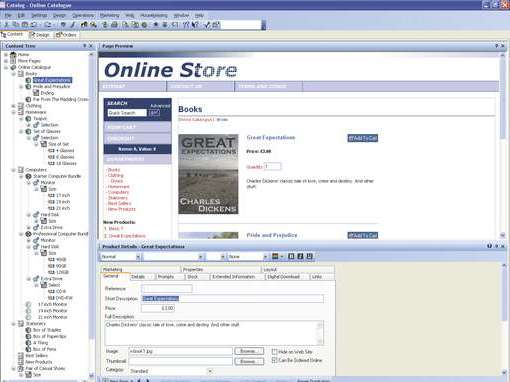TechRadar Verdict
An excellent all-in-one ecommerce package, capable of handling all the vital elements of any medium-level online store
Pros
- +
Stock monitoring
Payment processing
Marketing tools
Cons
- -
Overkill for smaller sites
Default designs are basic
Why you can trust TechRadar
Ecommerce. Getting the level correct is a real balancing act, with no perfect solution. At the lowest end of the scale, it's possible to get a store up and running almost immediately, but with no control over the process. At the highest end, huge, hulking server tools await you.
Actinic sits firmly in the middle of these two extremes, with a dedicated client application that does everything from designing your pages to receiving orders from your server, while pushing the most complicated elements into the background. However, 'most' is a relative thing. Actinic is overkill for smaller ecommerce sites, both in terms of scope and in its inherent complexity.
The default view is an average tree view of your store, taking in categories and products in the expected ways - products, attributes, choices, alternatives - but more in-depth controls are only a couple of mouse-clicks away.
As just one example, while Actinic sticks to a standard set of sample buttons and theme designs within the client application, seemingly restricting your stylistic aspirations to mere shaped buttons and colour schemes, it can plug straight into Dreamweaver for more advanced customisation options.
Seamless selling
Actinic produces a very powerful store, but it's in the running of it rather than the initial creation phase that it earns its money. Stock monitoring is built into the software, with the option to get a warning of upcoming issues and to decide how to deal with sold-out items - such as a message warning of delays, or flatout removing the ability to buy the product - on a product-by-product basis.
Neither side can keep tabs on the current state of play via live updates, only when the client connects to swap data, but when this does happen, the actual update process is seamless. Regardless of what you're selling, Actinic can fit it into the tree, along with all possible permutations, discounts, colours, styles, packaging styles, marketplaces, or anything else you might need.
Payment can be handled either by capturing the user's details for manual processing - Actinic warns you if you don't have SSL protection before you go ahead - or by passing the job on to a dedicated service provider, with all the usual suspects such as WorldPay and PayPal listed as options (needless to say, you need to have an account with said companies before you can start processing orders).
Sign up for breaking news, reviews, opinion, top tech deals, and more.
You can also make files available for digital delivery, simply by pointing Actinic to the relevant file and letting it upload it onto your web space. It creates its own links to the content for the purchaser, set to expire after an amount of time that you specify, and automatically marking the purchase as shipped in the back-end.
Even for orders involving the non-online world, Actinic provides plenty of assistance. New orders are presented in a simple list, complete with all the information on the who, what, where and hows of fulfilling them, with a set of sample templates to let people know when to sit by the doorstep and when the money has been taken.
Wider afield, Actinic also offers ways to make use of this data for future marketing, including focusing in on purchasers falling within a specific period, automatically building lists of popular products, and other such convenient tools. The potential catch with all this freedom is that getting your store up and running - that is, customised to your liking and mixed with other parts of your website - will involve a lot of effort before you're done.
The default designs are less than dazzling and making the finished result your own involves a lot of searching the interface for the different elements, including language snippets for prompts, writing up the templates for emails, structuring the site, and making sure that everything works together.
With all of that done, the actual day-to-day controls of running your own ecommerce site are simple enough for anyone to master, every major part of the process being broken up into simple-to-control tabs, with a focus on instant presentation of new data and oneclick control over ordering.
By default, Actinic is set up for an individual user to access the database and make the necessary changes, although it's possible to put together a multi-user environment as additional people are brought on board.
Actinic Catalog 8 is an excellent all-in-one ecommerce package, capable of handling all the vital elements of any medium-level online store. As we said at the start, for smaller sites, it's overkill - but for any reasonably sized site, or smaller sites that plan to become one, there's nothing better at this level.
Richard Cobbett
